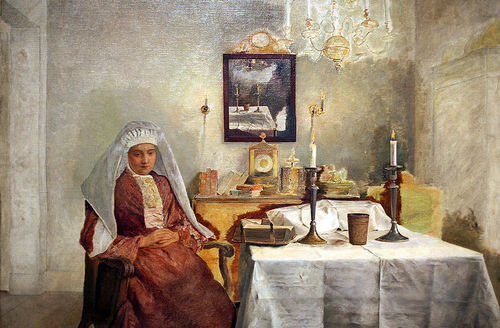 Photo credit: shooting brooklyn
Photo credit: shooting brooklyn
With this work I have recreated and inserted myself into the pictorial space and psychological setting of Isidor Kaufmann's The Friday Night, a painting from the early 1900's now in the permanent collection of the Jewish Museum (New York). Wearing a paper dress sewn from a dressmaker's paper pattern in the style of fancy evening wear, I engaged in the process of un-stitching and re sewing the pattern pieces to form a blanket in which I then wrapped myself. One of the questions central to this work is "How is it that we endlessly continue to conduct our lives in the patterns, even despite the patterns, of our heritage - individual and collective?"
The original painted image Friday Evening "depicts a lone woman seated beside a table prepared for the inauguration of the Sabbath. The two lit candles flickering on the heavily starched table linen indicate that she has already invoked the blessing which begins the Sabbath. One assumes that the sitter awaits the return of her husband from synagogue. The isolation of the sitter in Friday Evening is typical of Kaufmann's treatment of the religiously devout. These individuals at first seem rapt in their ritual observance. Yet their eyes are diverted from their spiritual mission and from the viewer. They are lost in a reverie which turns away from the material world toward the inner world of mysterious, often unresolved emotions."
"The model for the interior of this painting was the Sabbath Room designed by Kaufmann for the Old Jewish Museum of Vienna. On the wall in the background, we see the very typical mirror also shown at the Jewish Museum which reflects the Sabbath still life. Kaufmann's painting remained unfinished."
Clothing's role is "to display a unified identity while in reality holding together an always fragmented self. This is the self, or a self at least, that is exposed as coverings are removed... exposing what is constructed and perceived to be (the dress) as what really is; an envelope, an empty fragile shell with its covering function nevertheless intact. I don't want to know how it would be like to wear this dress. I take that back. I had forgotten that I knew, from endless childhood afternoons of tissue paper pattern battles. Fitting a paper dress means pinning against the skin, risking the occasional pricking, a manoeuvre taken with great care, for the pattern must go back into it's envelope ensuing the least of all possible damage, to be sewn again, as if for the first time. Depending on the fabric chosen, and the manipulation of the cut, you can make a very different dress, for a very different occasion, for a very different self, from the same pattern. And, consequently, another tale."
1 From a descriptive text by Norman Kleeblatt, Curator of Collections at the Jewish Museum,New York, 1985.
2 From the catalogue Isidor Kaufmann 1853-/ 1921 edited by G. Tobias Natter. JudischesMuseum de Stadt Wien, 1995.
3 From an essay entitled A Dwelling Place by Colette Sparkes, (unpublished, Montreal), 1997.